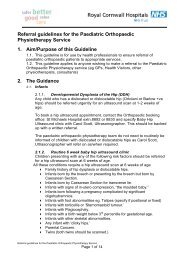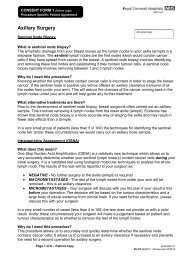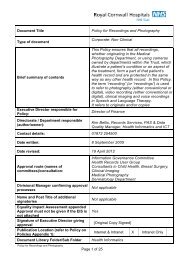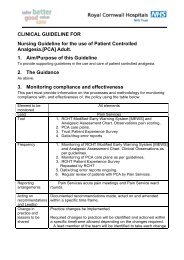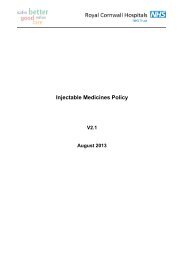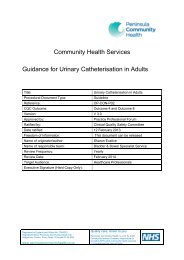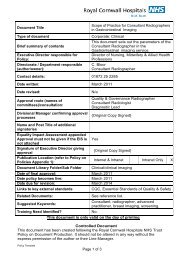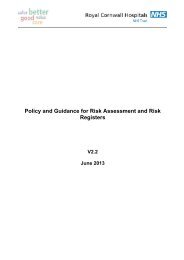Code of conduct for employees in respect of confidentiality
Code of conduct for employees in respect of confidentiality
Code of conduct for employees in respect of confidentiality
You also want an ePaper? Increase the reach of your titles
YUMPU automatically turns print PDFs into web optimized ePapers that Google loves.
6.4.1. be satisfied that patients know about disclosures necessary toprovide their care, or <strong>for</strong> local cl<strong>in</strong>ical audit <strong>of</strong> that care, that they can objectto these disclosures but have not done so (use the Care Record GuaranteeLeaflet on In<strong>for</strong>mation Shar<strong>in</strong>g <strong>in</strong> discussions with the patient);6.4.2. seek patients’ express consent to disclosure <strong>of</strong> <strong>in</strong><strong>for</strong>mation, whereidentifiable data is needed <strong>for</strong> any purpose other than the provision <strong>of</strong> careor <strong>for</strong> cl<strong>in</strong>ical audit – save <strong>in</strong> the exceptional circumstances describedbelow;6.5. You must treat <strong>in</strong><strong>for</strong>mation about patients and clients as confidential and use itonly <strong>for</strong> the purposes <strong>for</strong> which it was given. As it is impractical to obta<strong>in</strong> consentevery time you need to share <strong>in</strong><strong>for</strong>mation with others, you should ensure that patientsand clients understand that some <strong>in</strong><strong>for</strong>mation may be made available to othermembers <strong>of</strong> the team <strong>in</strong>volved <strong>in</strong> the delivery <strong>of</strong> care. You must guard aga<strong>in</strong>stbreaches <strong>of</strong> <strong>confidentiality</strong> by protect<strong>in</strong>g <strong>in</strong><strong>for</strong>mation from improper disclosure at alltimes.6.6. You should seek patients’ and clients’ wishes regard<strong>in</strong>g the shar<strong>in</strong>g <strong>of</strong><strong>in</strong><strong>for</strong>mation with their family and others. When a patient or client is considered<strong>in</strong>capable <strong>of</strong> giv<strong>in</strong>g permission, you should consult relevant colleagues. The duty <strong>of</strong><strong>confidentiality</strong> owed to a person under 16 is as great as that owed to any otherperson. But if the young person or another person, is at risk <strong>of</strong> serious harm, whichdisclosure to an appropriate person would prevent, that the need <strong>for</strong> this will beexpla<strong>in</strong>ed.6.7. If you are required to disclose <strong>in</strong><strong>for</strong>mation outside the team that will havepersonal consequences <strong>for</strong> patients or clients, you must obta<strong>in</strong> their consent. If thepatient or client withholds consent, or if consent cannot be obta<strong>in</strong>ed <strong>for</strong> whateverreason, disclosures may be made only where:6.7.1. they can be justified <strong>in</strong> the public <strong>in</strong>terest (usually wheredisclosure is essential to protect the patient or client or someone else fromthe risk <strong>of</strong> significant harm)6.7.2. they are required by law or by order <strong>of</strong> a court6.7.3. Where there is an issue <strong>of</strong> child protection, you must act at alltimes <strong>in</strong> accordance with national and local policies.6.8. Observe the pr<strong>in</strong>ciple that <strong>in</strong><strong>for</strong>mation given <strong>for</strong> one purpose may not be used<strong>for</strong> a different purpose without the permission <strong>of</strong> the <strong>in</strong><strong>for</strong>mant;6.9. Be aware that patients have a right to restrict disclosure <strong>of</strong> their personal<strong>in</strong><strong>for</strong>mation and as far as possible you must ensure that this right is adhered to and<strong>respect</strong>ed. A failure to do so could lead to discipl<strong>in</strong>ary action.6.10. If you have any concerns about disclos<strong>in</strong>g/shar<strong>in</strong>g patient <strong>in</strong><strong>for</strong>mation you mustdiscuss with your manager and if they are not available, someone with the same orsimilar responsibilities e.g. your Caldicott Guardian or Data Protection Officer/Head <strong>of</strong>In<strong>for</strong>mation Governance (see Appendix 3) If you cannot f<strong>in</strong>d anyone to discuss the<strong>Code</strong> <strong>of</strong> Conduct <strong>for</strong> Employees <strong>in</strong> Respect <strong>of</strong> ConfidentialityPage 6 <strong>of</strong> 18
issue with you should take down the callers details and contact them when you aresatisfied the disclosure <strong>of</strong> <strong>in</strong><strong>for</strong>mation can take place. The contact could be either viavoice or electronic media.6.11. Telephone Enquiries6.12. If a request <strong>for</strong> <strong>in</strong><strong>for</strong>mation is made by telephone,Always try to check the identity <strong>of</strong> the caller and check whether they are entitledto the <strong>in</strong><strong>for</strong>mation they request.Take a number, verify it <strong>in</strong>dependently and call back if necessary.6.13.Remember that even the fact that a patient is <strong>in</strong> hospital, a patient <strong>of</strong> the hospitalor a member <strong>of</strong> staff, is confidential. If <strong>in</strong> doubt consult your manager or the DataProtection Officer. It is safer not to disclose than to disclose <strong>in</strong>appropriately.6.14. Requests <strong>for</strong> In<strong>for</strong>mation by the Police and media6.15. With <strong>respect</strong> to the PoliceRequests <strong>for</strong> <strong>in</strong><strong>for</strong>mation from the Police should always be referred to the DataProtection Officer/Head <strong>of</strong> In<strong>for</strong>mation Governance or the RecordsServices/PAS Manager. Access to these people is available 24/7 viaswitchboard.6.16. With <strong>respect</strong> to the MediaDo not give out any <strong>in</strong><strong>for</strong>mation under any circumstances.6.17. Only the Director <strong>of</strong> Communication/Press Officer are authorised to do so and aresubject to national guidance on <strong>confidentiality</strong> <strong>in</strong> this <strong>respect</strong>. If you receive any requestfrom the media by personal visit or by phone refer the person to the Trusts Press Officer.RCHTPress Office Number 01872 25 2934Out <strong>of</strong> hours (24/7) Page via RCH switchboard6.18. Remember, the media may not always make their status apparent. If you have anyconcerns about the validity <strong>of</strong> a caller or visitor, please contact the Press Office.6.19. Disclosure <strong>of</strong> In<strong>for</strong>mation to Other Employees <strong>of</strong> the TrustIn<strong>for</strong>mation on patients should only be released on a need-to-know basis.Always check the member <strong>of</strong> staff is who they say they are.This can be achieved by check<strong>in</strong>g the employee’s ID badge and/or their <strong>in</strong>ternalextension number or bleep number prior to giv<strong>in</strong>g them any <strong>in</strong><strong>for</strong>mation.If possible also check whether they are entitled to the <strong>in</strong><strong>for</strong>mation.<strong>Code</strong> <strong>of</strong> Conduct <strong>for</strong> Employees <strong>in</strong> Respect <strong>of</strong> ConfidentialityPage 7 <strong>of</strong> 18
Don’t be bullied <strong>in</strong>to giv<strong>in</strong>g out <strong>in</strong><strong>for</strong>mation.If <strong>in</strong> doubt, check with the consultant/doctor <strong>in</strong> charge <strong>of</strong> the patient’s care. Orplease contact either the Data Protection Officer or Records Services Manager.6.20. Abuse <strong>of</strong> Privilege6.21. It is strictly <strong>for</strong>bidden <strong>for</strong> <strong>employees</strong> to look at any <strong>in</strong><strong>for</strong>mation relat<strong>in</strong>g tothemselves, their own family, friends or acqua<strong>in</strong>tances unless they are directly<strong>in</strong>volved <strong>in</strong> the patient’s cl<strong>in</strong>ical care or with the <strong>employees</strong> adm<strong>in</strong>istration on behalf<strong>of</strong> the Trust. Action <strong>of</strong> this k<strong>in</strong>d will be viewed as a breach <strong>of</strong> <strong>confidentiality</strong> and mayresult <strong>in</strong> discipl<strong>in</strong>ary action.6.22. If you require to see your own Health Record, you should make a SubjectAccess Request to the Disclosure Office.6.23. If you have concerns about this issue please discuss with your l<strong>in</strong>e manager.6.24. CarelessnessDo not talk about patients <strong>in</strong> public places or where you can be overheard.Do not leave any Health Records or confidential <strong>in</strong><strong>for</strong>mation ly<strong>in</strong>g aroundunattended.Make sure that the general public cannot see any computer screens, or otherdisplays <strong>of</strong> <strong>in</strong><strong>for</strong>mation. When leav<strong>in</strong>g your <strong>of</strong>fice, ensure you lock your PC, (Ctrl + Alt + Delete. Lock –Workstation or W<strong>in</strong>dows Key + L) or VDUSecure all portable <strong>for</strong>ms <strong>of</strong> data by lock<strong>in</strong>g them <strong>in</strong> a draw.Lock your <strong>of</strong>fice.You should not share your password with anyone, no matter how senior. (To doso would be a discipl<strong>in</strong>ary <strong>of</strong>fence)Do not transport confidential <strong>in</strong><strong>for</strong>mation <strong>in</strong> your car without adher<strong>in</strong>g to thecorrect procedure.• In secure bag• In boot <strong>of</strong> car• Not left unattended at any time. (<strong>in</strong>clud<strong>in</strong>g overnight)• Most importantly, with your l<strong>in</strong>e mangers permission.6.25. Use <strong>of</strong> Internal and External Post6.26. Best practice with regard to <strong>confidentiality</strong> requires that all correspondenceconta<strong>in</strong><strong>in</strong>g personal <strong>in</strong><strong>for</strong>mation should always be addressed to a named recipient.<strong>Code</strong> <strong>of</strong> Conduct <strong>for</strong> Employees <strong>in</strong> Respect <strong>of</strong> ConfidentialityPage 8 <strong>of</strong> 18
This means personal <strong>in</strong><strong>for</strong>mation/data should be addressed to a person, a postholder, a consultant or a legitimate Safe Haven, but not to a department, a unit or anorganisation. In cases where the mail is <strong>for</strong> a team it should be addressed to anagreed post holder or team leader.6.27. Internal mail conta<strong>in</strong><strong>in</strong>g confidential data should only be sent <strong>in</strong> a securelysealed envelope, and marked accord<strong>in</strong>gly, e.g. ‘Confidential’ or ‘Addressee Only’, asappropriate. When received <strong>in</strong> the department only the Addressee may open theenvelope unless others are authorised to do so.6.28. External Mail must also observe these rules. Special care should be taken withpersonal <strong>in</strong><strong>for</strong>mation sent <strong>in</strong> quantity, such as case notes, or collections <strong>of</strong> patientrecords on paper, CD or other media. These should be sent by Special Delivery or byNHS courier, to safeguard that these are only seen by the authorised recipient(s). Insome circumstances it is also advisable to obta<strong>in</strong> a receipt as pro<strong>of</strong> <strong>of</strong> delivery e.g.patient records to a solicitor.6.29. Electronic media should be protected. Advice on how to protect files is availablefrom CITS Support Centre on Ext 1717.6.30. Case notes and other bulky material should only be transported <strong>in</strong> the approvedboxes/bags and never <strong>in</strong> dustb<strong>in</strong> sacks, carrier bags or other conta<strong>in</strong>ers. Theseconta<strong>in</strong>ers should not be left unattended unless stored, wait<strong>in</strong>g <strong>for</strong> collection, <strong>in</strong> asecure area. The conta<strong>in</strong>ers should only be taken and transported by the approvedcarrier.6.31. If you are required to use your own vehicles to transport confidential<strong>in</strong><strong>for</strong>mation, it should be <strong>in</strong> a orange bag (where appropriate), <strong>in</strong> the boot <strong>of</strong> your carand not left unattended (unless as a part <strong>of</strong> an agreed work<strong>in</strong>g practice, normallywhere it would not be reasonable to take large quantities <strong>of</strong> records <strong>in</strong> to a patient’shouse). Records should not be left <strong>in</strong> vehicles overnight, they should be safely storedwith<strong>in</strong> the staff members premises.6.32. Blood samples etc. and the accompany<strong>in</strong>g request <strong>for</strong>ms should be treated asconfidential patient <strong>in</strong><strong>for</strong>mation and handled accord<strong>in</strong>gly.6.33. Fax<strong>in</strong>g6.34. All fax<strong>in</strong>g <strong>of</strong> <strong>in</strong><strong>for</strong>mation should be carried out <strong>in</strong> l<strong>in</strong>e with the Trust SafehavenPolicy and Procedure.6.35. Please see the Guidance <strong>for</strong> shar<strong>in</strong>g personal <strong>in</strong><strong>for</strong>mation by Fax, which shouldbe displayed <strong>in</strong> close proximity to the Fax Mach<strong>in</strong>e.• Remove patient identifiable data from any faxes unless you are fax<strong>in</strong>g to aknown secure and private area (known as Safe Havens).• Faxes should always be addressed to named recipients.• Use a fax header sheet with your contact details• Always check the number to avoid misdiall<strong>in</strong>g and r<strong>in</strong>g the recipient to checkthat they have received the fax.• If your fax mach<strong>in</strong>e stores numbers <strong>in</strong> memory, always check that the numberheld is correct and current be<strong>for</strong>e send<strong>in</strong>g sensitive <strong>in</strong><strong>for</strong>mation.<strong>Code</strong> <strong>of</strong> Conduct <strong>for</strong> Employees <strong>in</strong> Respect <strong>of</strong> ConfidentialityPage 9 <strong>of</strong> 18
6.36. Storage <strong>of</strong> Confidential In<strong>for</strong>mation6.37. Paper-based confidential <strong>in</strong><strong>for</strong>mation should always be kept locked away andpreferably <strong>in</strong> a room that is locked, and <strong>in</strong> some cases alarmed (e.g. GUM records)when unattended, particularly at nights and weekends or when the build<strong>in</strong>g/<strong>of</strong>fice willbe un-occupied <strong>for</strong> a long period <strong>of</strong> time.6.38. PC-based <strong>in</strong><strong>for</strong>mation should not be saved onto local hard drives or ontoremovable media, but onto the Trust network, CDs, and other media should be kept<strong>in</strong> locked storage.6.39. Encrypted memory sticks can be provided <strong>in</strong> some exceptional circumstanceswith the authorisation <strong>of</strong> l<strong>in</strong>e managers.6.40. Disposal <strong>of</strong> Confidential In<strong>for</strong>mation6.41. When dispos<strong>in</strong>g <strong>of</strong> paper-based person-identifiable <strong>in</strong><strong>for</strong>mation or confidential<strong>in</strong><strong>for</strong>mation always use ‘Confidential Waste’ sacks/shredders. (Please check with theNHS Records Management <strong>Code</strong> <strong>of</strong> Practice <strong>for</strong> retention and disposal details first)Keep the waste <strong>in</strong> a secure place until it can be collected <strong>for</strong> secure disposal.6.42. Computer pr<strong>in</strong>touts should either be shredded or disposed <strong>of</strong> as paper-basedconfidential waste.6.43. CDs conta<strong>in</strong><strong>in</strong>g confidential <strong>in</strong><strong>for</strong>mation must be destroyed. Computer files withconfidential <strong>in</strong><strong>for</strong>mation no longer required must be deleted from the server ifnecessary (no data is to be stored on the hard drives <strong>of</strong> PC’s). Destroy CDs bycutt<strong>in</strong>g through the disc.6.44. Computer hard disks are only to be destroyed/disposed <strong>of</strong> by the IT expertswith<strong>in</strong> the Trust.6.45. This is to ensure all <strong>in</strong><strong>for</strong>mation is deleted from the disk, as even by re<strong>for</strong>matt<strong>in</strong>git is possible to ga<strong>in</strong> access to the orig<strong>in</strong>al data.6.46. Patient Identifiable In<strong>for</strong>mation must be kept <strong>for</strong> a set period <strong>of</strong> time. This isoutl<strong>in</strong>ed with<strong>in</strong> Records Management <strong>Code</strong> <strong>of</strong> Practice. This <strong>in</strong>dicates the m<strong>in</strong>imumtime <strong>for</strong> which both medical and bus<strong>in</strong>ess NHS records should be reta<strong>in</strong>ed and setsout the legal obligations <strong>for</strong> all NHS bodies to keep proper records and the rules onarchiv<strong>in</strong>g or destruction. The Trust has a Records Management Strategy which hasbeen endorsed by the Trust Board.6.47. Further <strong>in</strong><strong>for</strong>mation is available from the Document Library.6.48. Confidentiality <strong>of</strong> Passwords, PIN numbers, etc6.49.Personal passwords, PIN numbers, etc issued to or created by <strong>employees</strong>should be regarded as confidential and they must not be communicated to anyone.Passwords, PIN numbers, etc should not be written down.<strong>Code</strong> <strong>of</strong> Conduct <strong>for</strong> Employees <strong>in</strong> Respect <strong>of</strong> ConfidentialityPage 10 <strong>of</strong> 18
Passwords, PIN numbers, etc should not relate to the employee or the systembe<strong>in</strong>g accessed.6.50. You will be given more <strong>in</strong><strong>for</strong>mation about their control and <strong>for</strong>mat etc. when youreceive your tra<strong>in</strong><strong>in</strong>g and/or password, PIN, etc.6.51. No employee should attempt to bypass or defeat the security systems orattempt to obta<strong>in</strong> or use passwords, PINs, etc or privileges issued to other<strong>employees</strong>. Any attempts to breach security should be immediately reported to the ITSecurity Manager and may result <strong>in</strong> discipl<strong>in</strong>ary action and also to a breach <strong>of</strong> theComputer Misuse Act 1990 and/or the Data Protection Act and may result <strong>in</strong> adiscipl<strong>in</strong>ary action and/or legal proceed<strong>in</strong>gs.6.52. Email<strong>in</strong>g Confidential In<strong>for</strong>mation6.53. Please see the “Email Policy” available on the Document Library.6.54. Patient identifiers should be removed wherever possible, and only the m<strong>in</strong>imumnecessary <strong>in</strong><strong>for</strong>mation sent, this may be considered to be the NHS number but noname or address. This <strong>in</strong> itself can pose problems as the wrong number may betyped.6.55. Special care should be taken to ensure the <strong>in</strong><strong>for</strong>mation is sent only to recipientswho have a “need to know “; always double check you are send<strong>in</strong>g the mail to thecorrect person/s.6.56. External transfers should only take place to persons with access to NHSnet/N3or approved recipients. Under no circumstances whatsoever should any type <strong>of</strong>patient identifiable <strong>in</strong><strong>for</strong>mation or sensitive or confidential <strong>in</strong><strong>for</strong>mation about any otherperson be e-mailed to persons who only have a Hotmail account, without thepermission <strong>of</strong> your l<strong>in</strong>e manger or the Data Protection Officer. Due to its <strong>in</strong>securenature any <strong>in</strong><strong>for</strong>mation transmitted over the Internet should be considered to be <strong>in</strong> thepublic doma<strong>in</strong>.6.57.See the Trust E-mail policy <strong>for</strong> more detailed <strong>in</strong><strong>for</strong>mation.6.58. Work<strong>in</strong>g at home6.59. The Organisation does not advocate the tak<strong>in</strong>g <strong>of</strong> person identifiableIn<strong>for</strong>mation or Records home <strong>for</strong> any reason. If you feel you have reason to do so,you MUST contact the Records Services Manager if they are cl<strong>in</strong>ical records or theCorporate Records Manager if they are corporate or bus<strong>in</strong>ess records to discuss priorto tak<strong>in</strong>g any records <strong>of</strong>f site.6.60. If you do have a justifiable reason to take patient or corporate records home,you must ensure they are securely stored to prevent accidental or malicious accessby non authorised people. It will be your responsibility to ensure they are recorded asbe<strong>in</strong>g <strong>in</strong> your possession and that they are safely returned.6.61. Copy<strong>in</strong>g <strong>of</strong> s<strong>of</strong>tware<strong>Code</strong> <strong>of</strong> Conduct <strong>for</strong> Employees <strong>in</strong> Respect <strong>of</strong> ConfidentialityPage 11 <strong>of</strong> 18
6.62. All computer s<strong>of</strong>tware used with the Trust is regulated by license agreements.A breach <strong>of</strong> the agreement could lead to legal action aga<strong>in</strong>st the organisation and/orthe <strong>of</strong>fender (member <strong>of</strong> staff).6.63. It is important that s<strong>of</strong>tware on the PCs/systems used <strong>for</strong> work purposes mustnot be copied and used <strong>for</strong> personal use. This would be a breach <strong>of</strong> the licenseagreement.6.64. General provisions6.65. Interpretation6.66. If any person requires an explanation concern<strong>in</strong>g the <strong>in</strong>terpretation or therelevance <strong>of</strong> this code <strong>of</strong> <strong>conduct</strong>, they should discuss the matter with their l<strong>in</strong>emanager, the Trust Data Protection Officer, Head <strong>of</strong> In<strong>for</strong>mation Governance, theCaldicott Guardian or the Records Services and PAS Manager.6.67. Non-Compliance6.68.Non-compliance with this code <strong>of</strong> <strong>conduct</strong> by any person work<strong>in</strong>g <strong>for</strong> the Trustmay result <strong>in</strong> discipl<strong>in</strong>ary action or crim<strong>in</strong>al charges be<strong>in</strong>g taken <strong>in</strong> accordance withthe Trust discipl<strong>in</strong>ary procedure, and may lead to dismissal <strong>for</strong> gross mis<strong>conduct</strong>.6.69.Breaches <strong>of</strong> the Data Protection Act 1998 could result <strong>in</strong> a f<strong>in</strong>e <strong>for</strong> the Trust fromthe In<strong>for</strong>mation Commissioners Office which could amount to £500,0006.70.Anyone found breach<strong>in</strong>g <strong>confidentiality</strong> could be sued by the data subject up to£5000.6.71. A record is kept <strong>of</strong> everyone who accesses <strong>in</strong><strong>for</strong>mation held on the Trustspatient based systems which is audited and can be made available to the patient.6.72. To obta<strong>in</strong> a copy <strong>of</strong> the discipl<strong>in</strong>ary procedures please discuss with yourmanager or the Personnel/Human Resources department or the Practice Manager.7. Dissem<strong>in</strong>ation and Implementation7.1. This document will be submitted to the Risk Management Committee <strong>for</strong>approval and follow<strong>in</strong>g approval will be dissem<strong>in</strong>ated to staff via the managementstructure. New and exist<strong>in</strong>g staff will be notified via the ‘Daily Bullet<strong>in</strong> when the policyis made available on the Document Library: They will be made aware <strong>of</strong> its contentsdur<strong>in</strong>g relevant risk management tra<strong>in</strong><strong>in</strong>g <strong>in</strong> l<strong>in</strong>e with the Tra<strong>in</strong><strong>in</strong>g Needs Analysis asoutl<strong>in</strong>ed <strong>in</strong> the RCHT Core Tra<strong>in</strong><strong>in</strong>g Policy.8. Monitor<strong>in</strong>g compliance and effectivenessElement to bemonitoredLeadThis Policy will be monitored entirety.Although the Head <strong>of</strong> In<strong>for</strong>mation Governance will lead this, it theresponsibility <strong>of</strong> all l<strong>in</strong>e managers to monitor their own areas <strong>of</strong><strong>in</strong>fluence.<strong>Code</strong> <strong>of</strong> Conduct <strong>for</strong> Employees <strong>in</strong> Respect <strong>of</strong> ConfidentialityPage 12 <strong>of</strong> 18
ToolFrequencyReport<strong>in</strong>garrangementsAct<strong>in</strong>g onrecommendationsand Lead(s)Change <strong>in</strong>practice andlessons to besharedDatix will be used to monitor the <strong>in</strong>cidents and risks that arerelevant to the content <strong>of</strong> the <strong>Code</strong> <strong>of</strong> Conduct.The management <strong>of</strong> risks and <strong>in</strong>cidents is an ongo<strong>in</strong>g processresult<strong>in</strong>g <strong>in</strong> real time cont<strong>in</strong>uous monitor<strong>in</strong>g.The In<strong>for</strong>mation Governance Committee will receive reports ateach meet<strong>in</strong>g; these will be tabled by the Head <strong>of</strong> In<strong>for</strong>mationGovernance.The IGC meets bi-monthly.Any recommendations or actions will be delegated to the relevantdepartmental lead as required.A report on progress will be required as directed by the agreedtimescale <strong>for</strong> completion.Significant changes to work<strong>in</strong>g practices will be dissem<strong>in</strong>ated viathe All Users Bullet<strong>in</strong>sA lead member <strong>of</strong> the team will be identified to take each change<strong>for</strong>ward where appropriate. Lessons will be shared with all therelevant stakeholders9. Updat<strong>in</strong>g and Review9.1. The <strong>Code</strong> <strong>of</strong> Conduct <strong>for</strong> Employees <strong>in</strong> Respect <strong>of</strong> Confidentiality is updatedand reviewed annually.10. Equality and Diversity10.1. This document complies with the Royal Cornwall Hospitals NHS Trust serviceEquality and Diversity statement.10.2. Equality Impact Assessment10.3.Please see appendix 2.<strong>Code</strong> <strong>of</strong> Conduct <strong>for</strong> Employees <strong>in</strong> Respect <strong>of</strong> ConfidentialityPage 13 <strong>of</strong> 18
Appendix 1. Governance In<strong>for</strong>mationDocument TitleDate Issued/Approved: 17 Dec 12Date Valid From: 17 Dec 12The <strong>Code</strong> <strong>of</strong> Conduct <strong>for</strong> Employees <strong>in</strong>Respect <strong>of</strong> ConfidentialityDate Valid To: 17 Dec 15Directorate / Department responsible(author/owner):Mark ScallanContact details: 01872 258580Brief summary <strong>of</strong> contentsSuggested Keywords:Target AudienceExecutive Director responsible <strong>for</strong>Policy:A code <strong>of</strong> <strong>conduct</strong> to <strong>in</strong><strong>for</strong>m staff how tohandle person identifiable <strong>in</strong><strong>for</strong>mationsecurely.<strong>Code</strong> <strong>of</strong> Conduct, Confidentiality, DataProtection, In<strong>for</strong>mation shar<strong>in</strong>gRCHT PCT CFTDirector <strong>of</strong> F<strong>in</strong>anceDate revised: November 2012This document replaces (exact title <strong>of</strong>previous version):Approval route (names <strong>of</strong>committees)/consultation:<strong>Code</strong> <strong>of</strong> Conduct <strong>for</strong> Employees <strong>in</strong> Respect<strong>of</strong> ConfidentialityIn<strong>for</strong>mation Governance CommitteeDivisional Manager confirm<strong>in</strong>gapproval processesName and Post Title <strong>of</strong> additionalsignatoriesSignature <strong>of</strong> Executive Director giv<strong>in</strong>gapprovalPublication Location (refer to Policyon Policies – Approvals andRatification):Document Library Folder/Sub FolderL<strong>in</strong>ks to key external standardsRelated Documents:Tra<strong>in</strong><strong>in</strong>g Need Identified?Head <strong>of</strong> Quality, Safety and ComplianceNot Required{Orig<strong>in</strong>al Copy Signed}Internet & Intranet Intranet OnlyHealth In<strong>for</strong>matics /In<strong>for</strong>mation GovernanceIn<strong>for</strong>mation Governance ToolkitData Protection PolicySafe Haven PolicyData protection and Caldicott GuidanceNo<strong>Code</strong> <strong>of</strong> Conduct <strong>for</strong> Employees <strong>in</strong> Respect <strong>of</strong> ConfidentialityPage 14 <strong>of</strong> 18
Version Control TableDateVersionNo19 Nov 12 V2.0V1.5 Initial IssueSummary <strong>of</strong> ChangesUpdated to reflect compliance needs with thePolicy on Policies.Previous version history not knownChanges Made by(Name and Job Title)Mark Scallan Head <strong>of</strong>In<strong>for</strong>mationGovernanceMark Scallan Head <strong>of</strong>In<strong>for</strong>mationGovernanceAll or part <strong>of</strong> this document can be released under the Freedom <strong>of</strong> In<strong>for</strong>mationAct 2000This document is to be reta<strong>in</strong>ed <strong>for</strong> 10 years from the date <strong>of</strong> expiry.This document is only valid on the day <strong>of</strong> pr<strong>in</strong>t<strong>in</strong>gControlled DocumentThis document has been created follow<strong>in</strong>g the Royal Cornwall Hospitals NHS TrustPolicy on Document Production. It should not be altered <strong>in</strong> any way without theexpress permission <strong>of</strong> the author or their L<strong>in</strong>e Manager.<strong>Code</strong> <strong>of</strong> Conduct <strong>for</strong> Employees <strong>in</strong> Respect <strong>of</strong> ConfidentialityPage 15 <strong>of</strong> 18
Appendix 2.Initial Equality Impact Assessment Screen<strong>in</strong>g FormName <strong>of</strong> service, strategy, policy or project (hereafter referred to as policy) to beassessed: <strong>Code</strong> <strong>of</strong> Conduct <strong>for</strong> Employees <strong>in</strong> Respect <strong>of</strong> ConfidentialityDirectorate and service area:Is this a new or exist<strong>in</strong>g Procedure? Exist<strong>in</strong>gIn<strong>for</strong>mation GovernanceName <strong>of</strong> <strong>in</strong>dividual complet<strong>in</strong>gTelephone: 01872 258580assessment: Mark Scallan1. Policy Aim* To <strong>in</strong><strong>for</strong>m staff <strong>of</strong> their responsibilities with regards to<strong>confidentiality</strong>.2. Policy Objectives* To ensure person identifiable data is handled securelythrough staff awareness.3. Policy – <strong>in</strong>tendedOutcomes*4. How will you measurethe outcome?5. Who is <strong>in</strong>tended tobenefit from the Policy?6a. Is consultationrequired with thework<strong>for</strong>ce, equalitygroups, local <strong>in</strong>terestgroups etc. around thispolicy?To m<strong>in</strong>imise <strong>in</strong>cidents and risks associated with the handl<strong>in</strong>g<strong>of</strong> confidential <strong>in</strong><strong>for</strong>mation.Through Datix reports and spot checks.All staff who handle person identifiable <strong>in</strong><strong>for</strong>mation.Nob. If yes, have thesegroups been consulted?c. Please list any groupswho have been consultedabout this procedure.*Please see Glossary7. The ImpactPlease complete the follow<strong>in</strong>g table us<strong>in</strong>g ticks. You should refer to the EA guidance notes<strong>for</strong> areas <strong>of</strong> possible impact and also the Glossary if needed.• Where you th<strong>in</strong>k that the policy could have a positive impact on any <strong>of</strong> the equalitygroup(s) like promot<strong>in</strong>g equality and equal opportunities or improv<strong>in</strong>g relationswith<strong>in</strong> equality groups, tick the ‘Positive impact’ box.• Where you th<strong>in</strong>k that the policy could have a negative impact on any <strong>of</strong> the equalitygroup(s) i.e. it could disadvantage them, tick the ‘Negative impact’ box.• Where you th<strong>in</strong>k that the policy has no impact on any <strong>of</strong> the equality group(s) listedbelow i.e. it has no effect currently on equality groups, tick the ‘No impact’ box.<strong>Code</strong> <strong>of</strong> Conduct <strong>for</strong> Employees <strong>in</strong> Respect <strong>of</strong> ConfidentialityPage 16 <strong>of</strong> 18
Equality Positive Negative No Reasons <strong>for</strong> decisionGroupImpact Impact ImpactAge No equality issues.Disability No equality issues.Religionbelie<strong>for</strong>No equality issues.Gender No equality issues.Transgender No equality issues.Pregnancy/ No equality issues.MaternityRace No equality issues.SexualOrientationMarriage / CivilPartnershipNo equality issues.No equality issues.You will need to cont<strong>in</strong>ue to a full Equality Impact Assessment if the follow<strong>in</strong>g havebeen highlighted:• A negative impact and• No consultation (this excludes any policies which have been identified as notrequir<strong>in</strong>g consultation).8. If there is no evidence that the policypromotes equality, equal opportunitiesor improved relations - could it beadapted so that it does? How?Full statement <strong>of</strong> commitment to policy <strong>of</strong>equal opportunities is <strong>in</strong>cluded <strong>in</strong> the policyPlease sign and date this <strong>for</strong>m.Keep one copy and send a copy to Matron, Equality, Diversity and Human Rights,c/o Royal Cornwall Hospitals NHS Trust, Human Resources Department, ChyveanHouse, Penvent<strong>in</strong>nie Lane, Truro, Cornwall, TR1 3LJA summary <strong>of</strong> the results will be published on the Trust’s web site.Signed ________________________________________Date _________________________________________<strong>Code</strong> <strong>of</strong> Conduct <strong>for</strong> Employees <strong>in</strong> Respect <strong>of</strong> ConfidentialityPage 17 <strong>of</strong> 18
PLEASE RETAIN FOR YOUR INFORMATIONAppendix 3. Contact In<strong>for</strong>mationCaldicott GuardianRoyal Cornwall Hospital NHS TrustDr Paul UptonCaldicott GuardianHead OfficeBedruthan HousePenvent<strong>in</strong>nie LaneTruroTR1 3LJTel: 01872 25 2223Fax: 01872 25 2944Data Protection OfficerRoyal Cornwall Hospital NHS TrustMr Mark ScallanHead In<strong>for</strong>mation GovernancePendowerRoyal Cornwall HospitalTruro TR1 3LJTel: 01872 25 8580<strong>Code</strong> <strong>of</strong> Conduct <strong>for</strong> Employees <strong>in</strong> Respect <strong>of</strong> ConfidentialityPage 18 <strong>of</strong> 18




